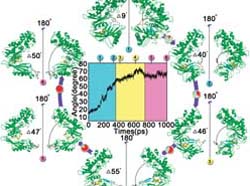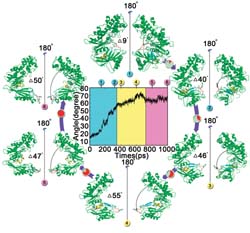

The conformational transition pathway of GK from the closed to the superopen state.
November 14 is the World Diabetes Day. More than 200 million people worldwide have diabetes. In China alone, about 60 million people are suffering from the disease. Fortunately, scientists are pushing back its boundaries. For instance, a recent study by CAS researchers may shed new light on the treatment of the disease by making cutting-edge progress on the studies of allosteric process of human glucokinase, which has been published by the latest issue of the
Proceedings of National Academy of Sciences (PNAS).
The lead authors, including ZHANG Jian and his supervisor JIANG Hualiang, are from the Center for Drug Discovery and Design, State Key Laboratory of Drug Research, Shanghai Institute of Materia Medica under CAS Shanghai Institutes for Biological Sciences.
Glucokinase (GK) is an important enzyme for regulating blood glucose levels and a potentially attractive target for diabetes of the young type II and persistent hyperinsulinemic hypoglycemia of infancy. The present studies are highly beneficial to understanding the mechanism of GK regulation and designing the compounds for treating metabolic diseases.
To investigate the allosteric process of human GK which is more associated with the conformational change from the closed to the superopen state, the researchers designed a series of conventional molecular dynamics (MD) and target MD (TMD) simulations and performed them on both the wild-type enzyme and its mutants. They discovered that the overall conformational transition includes three stages, and they identified three likely stable intermediate states by free energy scanning for the snapshots throughout the transition pathway. Moreover, the conformational transition feature revealed by the TMD simulations rationalized several important mutagenesis and kinetic data. The research also predicted that Y61S, I159A, A201R, V203E, and V452S mutations, which have not been investigated so far, may facilitate the opening process of GK. All these predictions have been verified by their mutagenesis experiments.
Now the researchers are focusing on the development of new medicines against type II diabetes according to the above research results on the allosteric process of GK.






